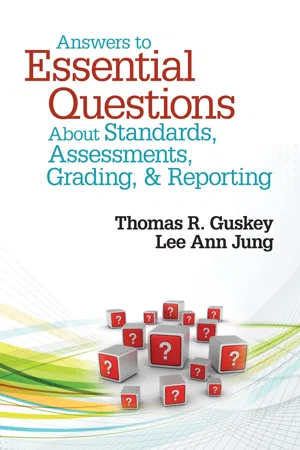
Answers to Essential Questions About Standards, Assessments, Grading, and Reporting
- 176 pages
- English
- ePUB (mobile friendly)
- Available on iOS & Android
Answers to Essential Questions About Standards, Assessments, Grading, and Reporting
About this book
The definitive guidebook to the complex terrain of 21st-century standards!
Standards, assessments, grading, and reporting provide the foundation for nearly every initiative in modern education reform. But what do these terms actually mean—and what changes in each area will bring about the improvements teachers and school leaders want to see? Here, Thomas R. Guskey and Lee Ann Jung collect the essential questions that stymie educators, and give each one a short, simple, jargon-free response.
Perfect for new teacher induction or professional learning on Common Core Standards initiatives, this book offers:
- A vocabulary and frame of reference to share with other educators
- An understanding of effective implementation in standards, assessments, grading, and reporting
- Specific ideas for purposeful action
Organized in a unique, accessible Q&A format, this easy-to-use guide gives educators the common ground they need for successful improvement efforts.
"This text is a useful tool that educators can use to build common definitions about frequently used and misunderstood educational terms within their state, district, or school. Only when educators have the same understanding of ?formative assessment? or ?grade reporting? can they be implemented with fidelity."
—Julie Quinn, Accountability Specialist
Utah State Office of Education, Salt Lake City, UT
"Written in small sections, this book explains well how we assess, why we use different assessments, and asks guiding questions for application of assessments. I highly recommend this book for anyone interested in educational assessments."
—Jeanne Collins, Superintendent
Burlington School District, VT
Frequently asked questions
- Essential is ideal for learners and professionals who enjoy exploring a wide range of subjects. Access the Essential Library with 800,000+ trusted titles and best-sellers across business, personal growth, and the humanities. Includes unlimited reading time and Standard Read Aloud voice.
- Complete: Perfect for advanced learners and researchers needing full, unrestricted access. Unlock 1.4M+ books across hundreds of subjects, including academic and specialized titles. The Complete Plan also includes advanced features like Premium Read Aloud and Research Assistant.
Please note we cannot support devices running on iOS 13 and Android 7 or earlier. Learn more about using the app.
Information
Part I Standards
1 What are Standards?


5. Use addition and subtraction within 100 to solve word problems involving lengths that are given in the same units, e.g., by using drawings (such as drawings of rulers) and equations with a symbol for the unknown number to represent the problem. (See http://www.corestandards.org/assets/CCSSI_Math%20Standards.pdf, p. 20)
References
Table of contents
- Cover
- Half Title
- Publisher Note
- Title Page
- Copyright Page
- Contents
- Acknowledgements
- About the Authors
- Preface: The Nature of Essential Questions
- Part I Standards
- 1 What are Standards?
- 2 Are Standards a New Idea in Education?
- 3 Why do Some People Oppose Standards?
- Part II Assessments
- 4 What is Assessment?
- 5 What is the Difference between Assessments and Tests?
- 6 What is Formative Assessment?
- 7 Why are Formative Assessments Important?
- 8 What are Common Formative Assessments?
- 9 What is Summative Assessment?
- 10 What is High-Stakes Assessment?
- 11 What are Instructionally Sensitive and Instructionally Insensitive Assessments?
- 12 How do Assessments for Learning Differ from Assessments of Learning?
- 13 Do Formative Assessments Improve Student Learning?
- Part III Grading
- 14 What are Grades?
- 15 What is the Purpose of Grading?
- 16 Are Grades Essential to Teaching and Learning?
- 17 Why are the First Grades Assigned So Important?
- 18 Do Low Grades Prompt Students to Try Harder?
- 19 Why Is Setting Percentage Cut-Offs for Grades an Arbitrary Process?
- 20 What is Wrong with Grading on the Curve?
- Part IV Reporting
- 21 What Criteria do Teachers Use in Assigning Grades?
- 22 What is Standards-Based Grading and Reporting?
- 23 Why do Some Parents have Concerns about Standards-Based Grading and Reporting?
- 24 If Schools Implement Standards-Based Grading, Will the Grades Assigned to Students Likely Go Up or Down?
- 25 What is the Most Important First Step in Implementing Standards-Based Grading?
- 26 What is the Best Way to Inform Parents about Moving to Standards-Based Grading?
- 27 What is the Best Way to Encourage Parents to Make Comments on the Report Card?
- 28 Will Standards-Based Grading Improve Student Learning?
- Part V Grading and Reporting for Exceptional and Struggling Learners
- 29 Who are Exceptional and Struggling Learners?
- 30 How do we Assign Grades to Exceptional and Struggling Learners who Require Modifications?
- 31 What is the Difference between Accommodations and Modifications?
- 32 How do we Legally Report Grades for Exceptional and Struggling Learners on Report Cards and Transcripts?
- 33 Do High School Students Requiring Modifications Receive Course Credit Toward a Diploma? Do Modifications Make a Student Ineligible for Extracurricular Activities, Such as Interscholastic Athletics?
- Summary and Conclusions
- Index